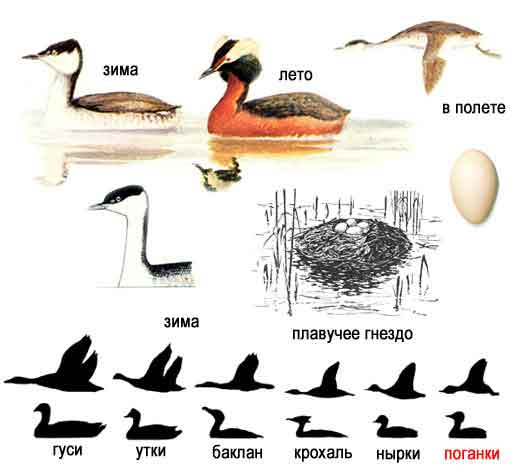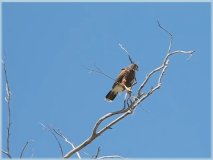|
Our
Beautiful World
|
Grebes, Genus Podiceps

Horned Grebe, Podiceps auritus, No: Horndykker
© www.ecosystema.ru/
|
Family Podicipedidae Grebes A grebe is a member of the Podicipediformes order, a widely distributed order of freshwater diving birds, some of which visit the sea when migrating and in winter. This order contains only a single family, the Podicipedidae, containing 22 species in 6 extant genera.
Great Crested Grebe, Podiceps cristatus, No: Toppdykker 
© http://www.ecosystema.ru/  © Arthur Grosset The Great Crested Grebe is distributed throughout most of Europe and across southern Asia to China. It is also found in Australasia and parts of Africa. Breeding is carried out in areas of fresh or brackish water with surrounding vegetation. Outside the breeding season it is to be seen at the coast or on large lakes.  Photo: Klaus Enslin, Wikimedia In breeding plumage it has a large black crest with black and rufous tippets. Sexes are similar but the female shows a shorter bill, a shorter crest and smaller tippets. Non-breeding adults lack the tippets.  Photo: Lukasz Lukasik, Wikimedia The Great Crested Greber, is No.1 in diving, but also on top when it comes to playing submarine, which it does when it is threatened. Then you can barely only see its head over the surface of the water. 
 Great crested grebe chicks with adults and territorial defence and courtship I - Granada Wild, c/o ITN Source, London II - BBC Natural History Unit http://www.arkive.org 
Great crested grebe diving and flying Granada Wild, c/o ITN Source, London http://www.arkive.org/  Wikimedia Often you may see adults swimming with their chickens on their back, and when they dive, the chickens grab a good hold, and sit there till they are back on the surface. There is a very beautiful picture of a bird with its chickens on the back here (click) Horned Grebe, Podiceps auritus, No: Horndykker  Horned grebe transition to breeding plumage. Location Codorus State Park, Hanover, Pennsylvania, USA © 2007 Henry T. McLin http://tolweb.org/onlinecontributors/app?page=ViewImageData&service=external&sp=20769 Horndykkeren finnes i et belte omrking hele den nordlige halvkule, især i overgangen mellom løvskogs- og barskogs-beltene og på skogssteppene i Russland og Canada, men utbredelsen når noen steder nord til den subarktiske skoggrense. De nordatlantiske bestander (Island, Skottland og Nord-Norge) er ganske isolerte. Horndykker i Norge finnes mest i vann med grunne partier på mineralrik berggrunn eller løssediment; disse stedene har rik bunnvegetasjon av tusenblad, tjønnaks og kransnålalger, samt et allsidig utvalg av vanninsekter, marflo og småfisk.  Location Potter's Marsh, Anchorage, Alaska, USA © 2007 Ashok Khosla http://tolweb.org/onlinecontributors/app?page=ViewImageData&service=external&sp=22399 Reiret plasseres som hos andre dykkere flytende i sivet, men horndykkeren synes å foretrekke forholdsvis lav vegetasjon av starr og elvesnelle, eller vierbusker ute i vannet. Etter eggleggingen kan enkelte par opptre svært skjult. Bestanden i Nord-Norge anslås til mellom 1000 og 1500 par. På 1800-tallet var den kun kjent fra noen få vann på Helgelandskysten. I nyere tid ser den ut til å ha innvandret fra landene øst for Østersjøen, og finnes da også på Østlandet. For hele landets vedkommende anslås bestanden til 2.500 par. (1981) Ovenstående data fra Norske fugler ved Jon Fjeldså http://www.birdlife.no/fuglekunnskap/fugleatlas/index.php?taxon_id=3094 In winter it can be confused with Svarthalsdykker, Black-necked Grebe Podiceps nigricollis , men siden den ikke finnes her, er det ingen fare for å ta feil..... Podiceps major Spydnebbdykker Great Grebe  Podiceps major Location Lican Ray, Araucanía, Chile © 2008 Pablo Caceres Contreras  adult in breeding plumage but with a blacker head. This belong to the race Podiceps major navasi found in the south of Chile and were taken on Lago Villarica (in pouring rain). © www.arthurgrosset.com Podiceps grisegena Gråstrupedykker Red-necked Grebe 
© http://www.ecosystema.ru/  Location Bronte Harbour, Oakville, Ontario, Canada © Mdf gråstrupedykker, silkedykker, Podiceps grisegena, fugleart i dykkerfamilien. Veier 500–900 gram, omtrent like mye som en lirype. Har kastanjebrun hals, svart kalott og nakke, grå kinn og strupe. Oversiden er brunsvart og undersiden hvit. Om vinteren forsvinner den brune halsfargen. Hekker oftest ved små, delvis gjengrodde vann. Gråstrupedykkeren er utbredt i østre deler av Europa og deler av Asia og Nord-Amerika.  © 2007 Sandy M http://tolweb.org/tree?group=Podiceps_grisegena&contgroup=Podiceps Er i Norge kun påvist hekkende i Troms, men sees ofte langs kysten utenom hekketiden, spesielt i Midt-Norge. De nærmeste hekkeområdene for øvrig er i Sverige, Finland og Danmark. Det foregår trolig et årvisst trekk av fugler fra Nord-Sverige og Finland til kysten av Midt-Norge. Ved sitat oppgi: Store norske leksikon, snl.no, Per Ole Syvertsen, 2010-10-27, http://www.snl.no/gr%C3%A5strupedykker
The decline of the Colombian grebe is attributed to wetland drainage, siltation, pesticide pollution, disruption by reed harvesting, hunting, competition, and predation of chicks by rainbow trout (Salmo gairdneri) (del Hoyo et al. 1992). The primary reason was loss of habitat: drainage of wetlands and siltation resulted in higher concentrations of pollutant, caussing (eutrophication) across Lake Tota. This destroyed the open, submergent pondweed (Potamogeton) vegetation and resulted in the formation of a dense monoculture of water weed (Elodea) (Varty et al. 1986, Fjeldsa 1993, as cited in O'Donnel and Fjeldsa 1997). By 1968 the species had declined to approximately
300 birds. Only two records of this bird was made in the 1970s; one
seen 1972, and the last confirmed record from 1977 when three birds
were seen. Intensive studies in 1981 and 1982 failed to find the species
and it is now considered extinct.
Its habitat is unique to the lake Chinchaycocha, to 4,080 meters above sea level. Its wings, normal size, lack the ability to fly by the weak development of their pectoral muscles. The diver is a kind of eco-tourism potential, not usually take refuge in vegetation, can be seen quite easily. It has a slim and elegant, was chosen as the emblem that symbolizes the richness of this ecosystem in the Andes of the country, the best place for resting and breeding waterfowl. Lake Junín in foreign and domestic tourists doing the "bird watching"or bird watching, where the diver is the goal of many naturalists.
|
 ANIMALS over 250 |
 BIRDS over 500 |
 FLOWERS over 225 |













